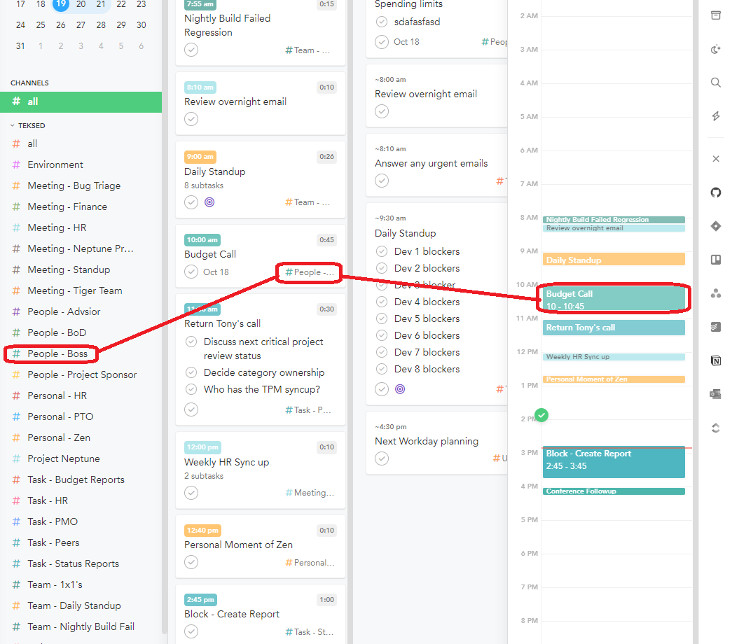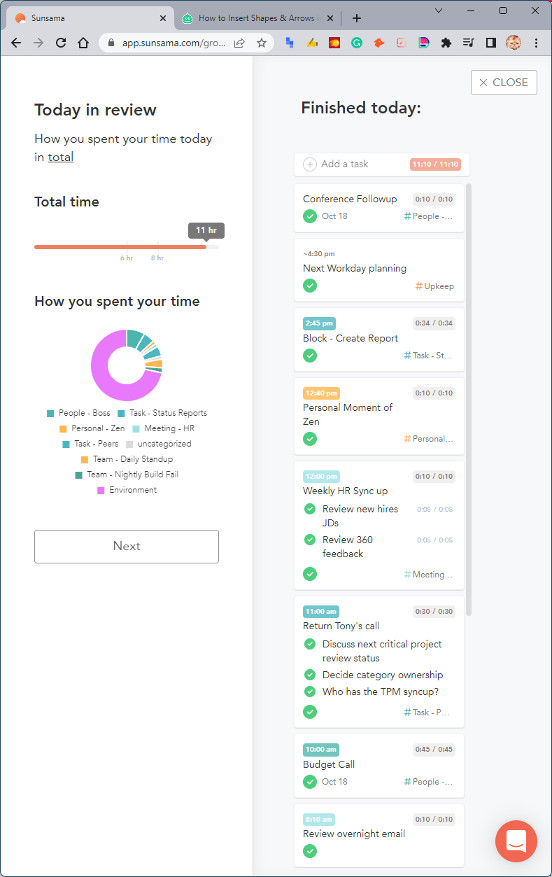Sometimes, after a long hard day, it feels like I haven’t made any meaningful progress. One reason for this is a lousy workday routine. Bad habits creep into my daily work and keep me from being more productive. In this article, I share some tips to help you find your best productivity habits. The key is Sunsama, which helps identify your habits and separate the good ones from the bad.
Using Sunsama to connect personal and work activities makes it easy to find your most effective habits. Sunsama points you to routines that allow you to be more productive and offer clues to others that slow you down. Sunsama helps track processes, identify critical people, flag effective work locations, and show times of the day when you are most effective.
Let’s look at some techniques.
Identifying Good Habits
A habit is a pattern of behavior that we do without thinking. Good habits are a great way to improve your life and help you be more productive. However, some habits can have the opposite effect and even impact your mental health and well-being.
I have found the key to refactoring my habits is to identify the good ones and let the bad ones go. Identifying good habits and incorporating them into my daily routine naturally isolates the bad ones because they interfere with the bad habits and limit the time to do them. This process has been so helpful because it helps me distinguish between two types of habits: automatic ones and deliberate ones.
Automatic habits are called “habit loops” because they start from a small environmental cue that prompts us into an unconscious routine. While “habit” is often used for these reflexive behavior patterns, I think of them as automatic routines.
For example, suppose I need a task completed that seems technically difficult. In that case, I generally kick into an automatic routine and assign it to my most senior or trusted developer. The process is an example of an automatic routine because once the habit loop is triggered, my brain speeds through the decision process without thinking.
I label, record, and review what I’ve done at the end of the workday to find good habits. This is the beauty of Sunsama. Since it is integrated into my personal and work life, the signs of good and bad habits can be identified, particularly if personal bad habits are impacting my work.
Make sure to integrate Sunsama with your social media accounts including personal calendars. Using the #all channel, you can see your personal and work tasks together to give you a sense of how busy your life is.
If you are looking for more ways Sunsama can help you, check out my other post.

Think About People
Ultimately the people we work with influence our habits. People are the most important part of a company. They are the ones who make it work, who make it succeed. But we aren’t compatible with everyone. It is best to identify those we work best with and those we don’t.
I am more creative working with some people and less with others. However, while I may not be compatible with everyone, others have more influence and control in certain areas than I do. I actively seek to recognize both types and note them in Sunsama.
If I find someone I work well with I want them to influence my habits positively. I ask them for help and try to incorporate them into my daily routines, projects, or tasks. This works even better if this person is my boss. One final note, I’ve found there are some people who are supportive of my projects or objectives and others who are not. I keep track of who supports me and include them in meetings.
In Sunsama, I create separate channels for the essential people I work with. I can see how much time I spend with them and understand how impactful I am with them and when. Sometimes I get hangry before lunch, so I try not to schedule meetings with my boss at that time..

Find the Whats
Another key to identifying a good habit is recognizing the targets. Assessing how well I achieve targets reveals habits that work and those that don’t. Identifying the things I need to accomplish is critical. My work habits should be centered on a company goal or objective. Generally speaking, I have found the “whats” are goals, Key Process Indicators (KPIs), or processes. If my goals are not achieved, it might be time to stop doing something. Sunsama is the tool I use to sort this out.
If my goals aren’t being tracked, I need to follow them. Tracking progress toward them makes it easier to see if a habit is working. If objectives aren’t clearly stated, they need to be clarified. Did I break down barriers to achieve the goals? These are good candidates for new habits.
If processes aren’t documented, look for opportunities to do that too. I ask myself if I followed a process exceptionally well. Did I deviate from the process or invent a new one?
At the end of the day, during my Sunsama wrap-up, I reflect on what i did during the day. I like to review the tasks and think about who I met with and what I accomplished. I know I probably need to review my email before the Nightly Build Fail meeting,

Does the Environment Impact Your Habits?
The environment I work in has a significant impact on my habits. The location I choose to accomplish my goals, whether working out or at the office, can significantly affect how I feel and how productive I am. For example, suppose I’m trying to work on a sizeable critical project task at home but can’t focus because of all the home distractions. In that case, it might be better for me to go somewhere else, like a coffee shop, library, or remote office location.
If I’m trying to be creative and find myself struggling with motivation or just not feeling inspired, it could be because of where I’m located. I suggest exploring how different locations impact your habits and how you might use that knowledge to your advantage.
Using Sunsama channels, objectives, and tasks, I can reflect on where I have been and how effective I was at those times.

When Are Your Best Habits Most Effective?
Everyone has a different schedule and routine. You may find that your best habits are most effective in the morning, midday, or evening. It is important to note what times of the day you are likely to get things done and notice how exhausted you become throughout the day.
It will be easier for you to focus on tasks if you know your energy levels are at their highest at certain times of the day. Some people find that they can only concentrate for about 90 minutes before becoming exhausted and needing a break. Others may have a burst of energy in the morning but find themselves drained by midday. This will help you figure out what times of the day work best for you and your activity goals.
I find mornings are the most productive time for me. I try to schedule personal tasks as the day is new, and I’ve recently woken up, had coffee, and not been burdened with too many distractions. My energy levels are high enough to focus on the most important personal tasks. I have also found that the more complex and demanding my schedules, I can only get things done in the early morning.
In Sunsama, once I shut down for the day, I reflect on what I did and adjust my next day based on what I have learned to start creating better habits.


Conclusion
In this article, I shared the things I do to identify good workday habits and hope you found them helpful too. I’ve used these techniques and have tested them with my developers, who are now flourishing. I hope these tips will help your career or make your work life more productive.



